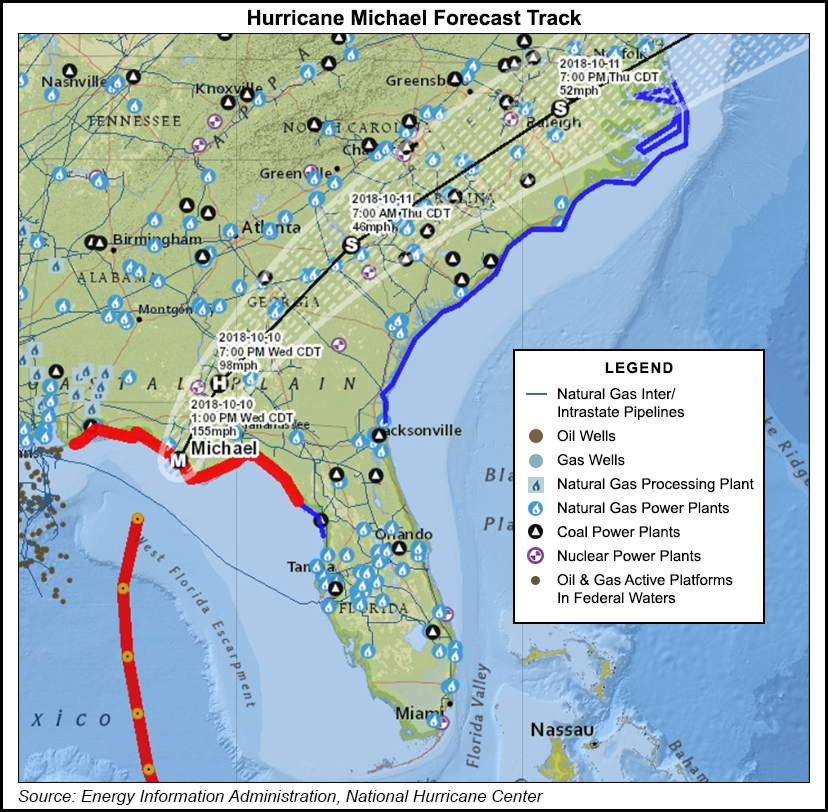NGI The Weekly Gas Market Report | E&P | Infrastructure | Markets | NGI All News Access
NatGas Supply, Demand Impacted as Michael Crashes Into Florida Panhandle
Hurricane Michael strengthened into a devastating Category 4 storm before making landfall over the Florida Panhandle Wednesday, causing power outages and oil and gas production shut-ins as it delivered powerful winds, life-threatening storm surge and heavy rains.

As of 5 p.m. ET Wednesday, Michael, downgraded to a Category 3, was 5 miles northwest of Mexico Beach, FL, traveling north-northeast at 14 mph, according to the National Hurricane Center (NHC). The forecaster was expecting the storm to turn to the northeast later Wednesday.
“A motion toward the northeast at a faster forward speed is forecast on Thursday through Friday night,” NHC said. The forecast track showed Michael moving across southeastern Alabama and southwestern Georgia Wednesday before traveling over the southeastern United States through Thursday.
Governors for Florida, Alabama and Georgia had all declared states of emergency as the storm thrashed the mainland with maximum sustained winds of 155 mph.
Based on operator reports, the Bureau of Safety and Environmental Enforcement estimated Wednesday that 812 MMcf/d (31.7%) and 718,877 b/d (42.3%) of Gulf of Mexico production had been shut in due to Michael. A total of 89 platforms and three rigs had been evacuated, while four dynamically positioned rigs had been moved off location out of the storm’s path.
Genscape Inc. said its pipeline production estimate Wednesday showed Gulf of Mexico volumes dropping to 1,557 MMcf/d, down more than 1.34 Bcf/d from last Thursday.
Nautilus Pipeline LLC on Tuesday declared a force majeure at the Manta Ray B meter gathering system offshore Louisiana due to Michael, Genscape analyst Dominic Eggerman noted.
“Nautilus will evacuate all personnel from the Ship Shoal 207 platform, resulting in a shut in of the receipt meter until further notice,” Eggerman said. “The Manta Ray B meter has already begun reducing nominations since Oct. 5, likely in preparation for the hurricane.
“Previous 30-day receipts averaged 204 MMcf/d but have already fallen to 23 MMcf/d” for Tuesday’s gas day prior to the declaration of the force majeure. “Overall, we can expect cuts of around 204 MMcf/d compared to traditional flows until Hurricane Michael passes and personnel can resume their roles in safer weather conditions.”
On the demand side, electric utilities were working to respond to hundreds of thousands of reported customers outages as Michael hammered the Florida Panhandle Wednesday.
Gulf Power was estimating that 225,000 customers could lose power due to the storm, while Duke Energy was bracing for 100,000-200,000 outages in its Florida territory.
“Historical data and company experience indicate complete restoration from a storm of this magnitude could take multiple days to over a week — depending on the extent of actual damage, crews’ ability to access remote areas and islands, and conditions following the storm, such as flooding,” Duke said.
Alabama Power said it had 600-700 crews deployed to the southeast part of the state to conduct storm-related restoration. The utility also said its Plant Farley Nuclear Plant was ready for the storm, with operator Southern Nuclear reducing power at the plant’s units 1 and 2 as a precaution.
Genscape’s statewide sample power burn for Florida came in at 3.93 Bcf/d for Wednesday, roughly flat day/day but down around 420 MMcf/d from last week’s weekday average, according to the firm’s senior natural gas analyst Rick Margolin.
“The speed of the storm is a variable that may influence the bearish impact of the event,” Margolin said. “Production should recover fairly quickly as crews return to offshore facilities (assuming no major damage to equipment). On the demand-side, the fast and relatively concentrated movement of the storm could shorten the duration of any demand destruction.
“However, the storm’s velocity is due to the strength of the storm, which — despite a relatively brief presence — could be severe.”
© 2024 Natural Gas Intelligence. All rights reserved.
ISSN © 1532-1231 | ISSN © 2577-9877 | ISSN © 1532-1266 |
